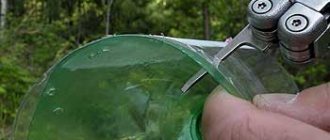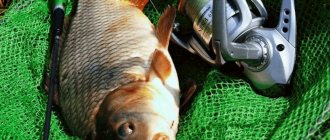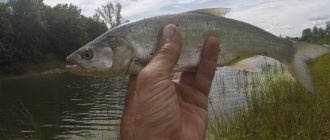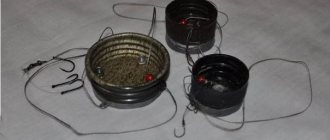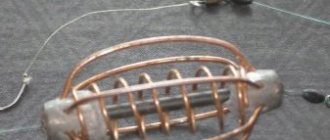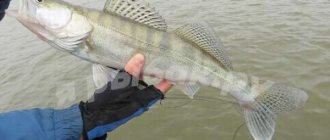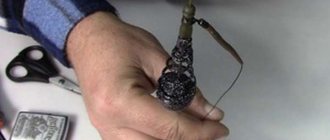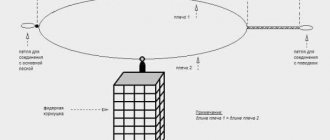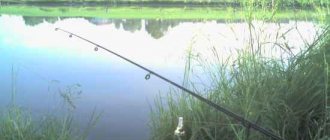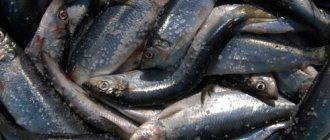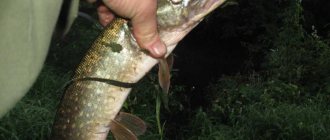Collecting tackle
To make this simple equipment yourself, you will need the most ordinary plastic bottle from any drink. Its volume should be 2 l, 2.5 l or 3 l. You also need to tie a fishing line to the bottle, the diameter of which does not play any role at all, but if you are counting on a trophy specimen, then the fishing line will need to be stronger, and therefore thicker. But its length should be at least 8 - 10 meters. The fishing line is wound around the recesses on the bottle. In addition, the hook must be equipped with a sliding sinker weighing approximately 100 grams, a leash, a double hook, a clasp with a swivel and an elastic band. The video describes in detail the principle of catching trick bottles. Although the fishing technique is quite similar to the principle of fishing with stands, girders or circles.
Tackle design
For fishing from a boat
To make fishing tackle from a plastic bottle, you will need a vessel of suitable volume and a fishing line or nylon cord 8-16 m long. They are attached to the future tackle in the neck area. For greater reliability of fastening, you can make holes in the cork or neck through which the cord will be threaded: this way you will be sure that the bottle will not come undone after prolonged use.
A sinker is attached near the end of the fishing line or cord. A sinker tied to the end of the fishing line can have a mass of up to 100 g and must be sliding. In some cases, you can use more massive objects that will help hold the tackle in the installation location.
The attached cord or fishing line is folded into a knotted loop to which a metal leash is attached. It will carry a hook, the size of which can also vary depending on the size of the expected catch.
The technique of fishing with a bottle from a watercraft is simple. In order not to miss the moment of a bite, you can apply stripes of paint or other marks on the bottle, which will show its change in position. The level of the marks must be chosen taking into account the fact that when fishing, the bottle needs to be filled 2/3 with liquid so that it remains on the surface of the water with the neck down.
For shore fishing
The device for catching pike from the shore differs from the version for fishing from a boat in that the cord is attached to the bottle not only in the neck area: you need to wind another 5-8 m at the narrowing point of the container for a more reliable fixation. Using a cord, the tackle will be connected to the shore.
A sinker is attached to the end of the cord, which can be made motionless. A steel leash is attached 0.5 m above it.
The moment of the bite is determined by the movement of the bottle on the surface of the reservoir. It is not necessary to monitor the bottle; it can be attached to the nearest strong branch at night. The gear is checked in the morning for the presence of a catch.
For successful fishing from the shore, you need to choose the correct casting distance and evaluate how well the bottle is secured.
Choose a place to install the trap so that the coastal zone is as free as possible from algae and other underwater obstacles that the gear can get caught on.
Fishing principle
Once the required depth has been measured, you should place the fishing line behind the elastic band attached to the bottle and secured to it. The double hook should have a live bait fish attached to it. You should first pour a little water into the bottle so that, once in the reservoir, the drop bottle is at a certain slope.
When a predatory fish bites, it swallows the live bait fish, throwing the fishing line off the elastic. When the line is unwound to its full length, the bottle will change its position, which will serve as a signal to the fisherman that a bite has occurred and a fish has been hooked.
Trick bottles can be placed around the reservoir, using a floating device, in places that are promising for fishing, where fish camps are supposed to be located.
If you attach a worm instead of live bait, you can count on a carp bite
After the hooks are in their places, the fisherman just has to wait for the coveted bites. It is important not to miss bites!
How to catch pike with a bottle
A pike fishing bottle works the same way as a circle. The advantage of this device is that it is easier to manufacture and can be used even by novice fishermen.
The best time to fish with a bottle is during Indian summer. At this time, for successful fishing in this way, you need to choose a large body of water in which large animals live. If you plan to use live bait, you need to choose a river or lake that contains a lot of pike, perch, and pike perch. It is not recommended to choose small bodies of water, because... It will be more difficult to choose a bait that will definitely bite.
Having chosen a suitable place for fishing, take care of the reliability of attaching the live bait. Place it on the hook using one of the following methods:
- Behind the back: the hook is inserted under the dorsal fin so as to securely fix the bait without damaging the spine. The latter can lead to the fish stopping moving and the pike not seeing it in the water.
- By the lip: the hook is fixed on the upper lip of the bait so that it cannot come off during movement.
- By the gills: the end of the hook for attaching to the fishing line is inserted into the mouth cavity of the bait, brought out through the gills, then secured. With this method, the baitfish is not injured, so it can attract predators longer.
- By the tail: to secure the live bait in this way, you must first wrap its tail with thread, then thread the hook under it.
Trick bottle: How to make catchy, strong tackle for large fish with your own hands?
In the twenty-first century, sport fishermen do not make tackle, because many overpriced analogues have appeared in modern stores. It is easier for an amateur to spend more money by purchasing a ready-made installation.
If you pay attention to experienced fishermen who have been fishing for a long time, then in their bags there are homemade, wonderful montages.
A modern fisherman sometimes doesn’t understand why his expensive rod with rigs doesn’t catch anything, but his unsightly-looking grandfather, with some incomprehensible homemade product, pulls in fish.
Homemade fishing gear is good because it does not require large financial costs. The fisherman, first of all, makes them for himself, which is why the tackle turns out to be reliable and convenient.
The unique tackle has small dimensions. To fish with it, no fishing rod is required, so the fisherman can always transport it in the car.
How the zakidushka is completed
The zakidushka tackle consists of several important elements.
This:
- Hook.
- Fishing line.
- Sinker.
Each element in the bundle plays its role.
Hook
You can find any hook on sale today. If so, then you should choose the most suitable one. Beginners will probably be confused, especially when they see that there are some numbers on the box. However, there is nothing complicated about it. You need to know that the main size is the width, which is how the product number is determined. By the way, domestic and foreign manufacturers may have the same hook with a different number, since there is a different classification.
fishing line
Fishing line is another element that the store has in abundance. The difference lies not only in diameter, as many believe, but also in material. It can be monofilament or braided cord. If you are doing the casting yourself, then you can pay attention to monofilament fishing line, with a cross-section of 0.2-0.6 mm. As for leashes, a diameter of 0.10-0.12 mm is quite sufficient.
Important! The parameters of the fishing line directly depend on the fish that the fisherman is going to hunt.
Sinker
The presented element can be bought in a store, then the weight of the part should be in the range of 100-150 grams, and found in your yard or right on the shore. In the second case we are talking about a stone, a piece of brick and the like. The main thing is to choose flat products so that they do not roll along the bottom.
Catching tackle for large fish - a bottle-snack
The tackle bottle is a plastic bottle (0.5 l, 2 l), which should act as a spinning reel.
Main monofilament line: long (25 m), diameter (0.2 mm, 0.4 mm), wound around the bottle.
A drop-shaped sinker weighing from 100 g is tied to the end of the fishing line. A retractable leash is attached at a distance of 50 cm. The diameter of the leash should be from 0.1 mm to 0.2 mm, and its length should be 10 cm or 20 cm.
Any hooks are used at the discretion of the user. They should be sharp enough to catch the fish.
Any standing pond or backwater is suitable for fishing with this tackle. The main thing is that the chosen fishing spot has a steep and deep descent.
Having equipped the hook with a nozzle, the amateur angler must unwind a little of the main line for free casting.
Next, you need to spin the tackle like a sling, then make a throw. The line unwinds freely from the bottle due to the weight of the weight and low friction with the bottle.
The main advantage of the gear is its low cost and ease of manufacture. The tackle is very compact and does not take up much space.
What other fish are caught with a bottle?
The goal of bottle fishing is not always to catch pike. You can also catch other large fish with this tackle:
- carp;
- soma;
- pike perch.
In addition to predatory fish, in a similar way in summer you can also catch small fish for fishing or for bait. But in this case, the trap will be made in a slightly different way.
A suitable vessel is selected, from which the neck is cut off so that a kind of funnel is obtained.
The cut part is inserted into the bottle upside down. Using an awl or other sharp object, holes are made in both parts of the trap; a fishing line or cord must be passed through these holes to secure it. Do not cut off their ends, make loops out of them, with which the improvised top will be attached to pegs driven into the bottom.
Throw bread crumbs, dough or other bait into the bottom of the bottle
You can add something shiny there that will attract the attention of the fish. Attach the trap to the pegs horizontally and check it periodically for catches.
A little background
It was autumn outside, in one of the villages located on the banks of a river, I saw a local fisherman grandfather, walking along the bank, throwing plastic bottles into the water. I purposefully went to my grandfather to tell him about the environment, that there is a lot of garbage. However, when I got very close, I noticed that each bottle had a fishing line wound around it. My interest knew no bounds (I had never seen anything like this before).
Approaching the fisherman, I said hello and asked: “What is this and why is he doing this?!” My grandfather answered this question: “Such a tackle!”
After the fisherman grandfather finished arranging his bottle tackle, he explained in detail what kind of tackle it was and how to catch fish with it.
What is needed to make this gear?
— We will need a regular plastic bottle. Mineral water, soda, etc. are sold in such containers, so finding it will not be difficult. Grandpa takes bottles from the garbage that fishermen scatter along the banks.
Friends, take care of nature, take your trash with you and throw it in the trash. It's a shame when grandpa goes and collects trash for careless vacationers
For this gear, it is best to use bottles with a volume of 1.5 liters or more.
— Fishing line or braid. As the fisherman grandfather said: “Take any thickness, the main thing is that it is 10 meters.” This line must be wound around the hole (recess) in the middle of the bottle.
- Cargo. I didn’t have any scales with me, but off the top of my head, grandpa used weights weighing 100-150 grams.
- Leash. His leashes were homemade, made of thick fishing line.
— You need 2 rubber bands. One serves as a stopper when unwinding. The second serves as a shock absorber when biting and is located near the sinker.
Casting a donkey sinker from a bottle
Before casting the bottom tackle, we mount a leash(s) with a sinker in a carabiner tied to the end of the main fishing line.
We bait or place baits on the hook(s), and take the bottle with the donkey bait wound in one hand. Next comes the unusual process of casting bottom gear, which you need to pay attention to.
To throw a load of tackle, the bottle in the neck area is clamped in the left hand. With the right hand, either immediately or from the bottom swing, the donkey load is thrown.
The following is an important piece of advice for beginners. At the moment the load leaves the hand, the longitudinal axis of the donkey bottle should be located on the same axis with the flight path of the load, or even better, track it.
The aerobatics of casting a sinker with a bottom wound on a bottle is when the bottom of the bottle drops following the approach of the sinker of the tackle to the water. In this case, minimal friction of the fishing line is ensured when leaving the surface of the bottle and, accordingly, the maximum flight range of the sinker of the bottom tackle.
Next, we attach a bottle of donkey to the rod, insert a fishing line into the slot of the rod and wait for a bite. A bite alarm for daytime fishing is a bell suspended on a fishing line.
If you only have one bottom boat or a small number of gear (2-3) and they are arranged compactly, then to record bites on the bottom gear you can put visual weights - heavy bite alarms that are much less likely to be swayed by the wind.
But if you plan to fish with the same bottom gear not only during the day, but also at night, then we will continue making a bottom for round-the-clock fishing. To do this, we will install a light electronic bite alarm in a donkey yogurt bottle.
